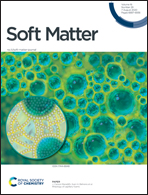Elasto-morphology of P3HT:PCBM bulk heterojunction organic solar cells†
Abstract
Predicting the mechanical properties of organic semiconductors is important when using these materials in flexible electronics applications. For instance, knowledge of the mechanical and thermal stability of thin film organic solar cells (OSCs) is critical for the roll-to-roll production of photovoltaic devices and their use under various operating conditions. Here, we examine the thermal and elasto-mechanical properties of the conjugated donor polymer poly-(3-hexylthiophene) (P3HT) and the interpenetrating mixtures of P3HT and phenyl-C61-butyric acid methyl (PCBM) ester bulk heterojunction (BHJ) active layers under the application of unidirectional tensile deformation using coarse-grained molecular dynamics (CGMD) simulations. The predictions are validated against previous experimental reports as well as with earlier modeling results derived using different intermolecular force fields. Our results reveal that PCBM molecules behave as anti-plasticizers when mixed with P3HT and tend to increase the tensile modulus and glass transition temperature, while decreasing the crack-onset strain relative to pure P3HT. The variations in the mechanical properties with the composition of the BHJ active layer suggest that, in the presence of small oligomers as additives in the BHJ, the P3HT:PCBM mixture resists the anti-plasticizing effect of PCBM molecules due to the low tensile modulus of the short polymer chains.

- This article is part of the themed collection: Soft Matter Most Popular 2020


 Please wait while we load your content...
Please wait while we load your content...